Attached files
| file | filename |
|---|---|
| 8-K - FORM 8-K - ENDURANCE SPECIALTY HOLDINGS LTD | d593634d8k.htm |
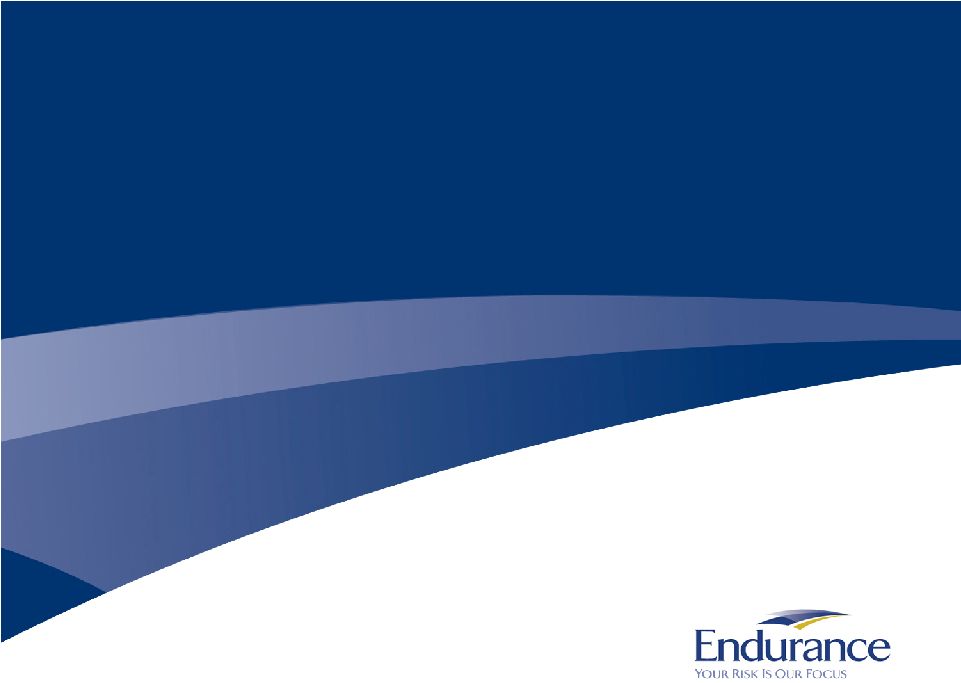 Endurance
Specialty Holdings Investor Presentation
June 30, 2013
Exhibit 99.1 |
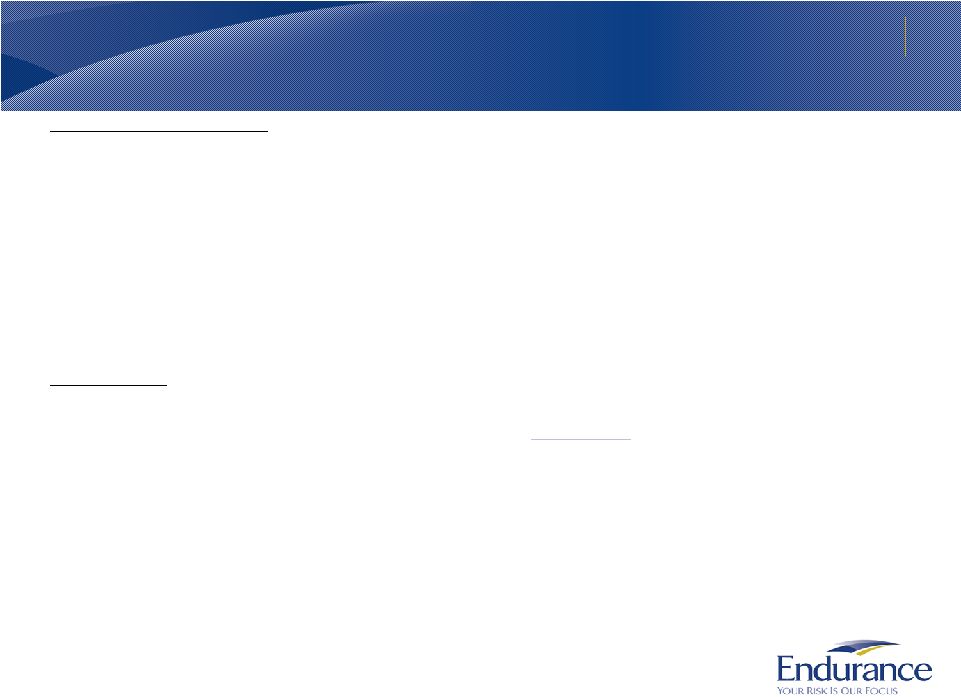 Forward looking
statements & regulation G disclaimer Safe Harbor for Forward Looking
Statements Some of the statements in this presentation may include forward-looking
statements which reflect our current views with respect to future events and financial performance. Such
statements include forward-looking statements both with respect to us in general and the
insurance and reinsurance sectors specifically, both as to underwriting and investment
matters.
Statements
which
include
the
words
"should,"
"expect,"
"intend,"
"plan,"
"believe,"
"project,"
"anticipate,"
"seek,"
"will,"
and
similar
statements
of
a
future
or
forward-
looking
nature
identify
forward-looking
statements
in
this
presentation
for
purposes
of
the
U.S.
federal
securities
laws
or
otherwise.
We
intend
these
forward-looking
statements
to
be covered by the safe harbor provisions for forward-looking statements in the Private
Securities Litigation Reform Act of 1995. All forward-looking statements address
matters that involve risks and uncertainties. Accordingly, there are or may be important factors that could cause actual results to differ from
those
indicated
in
the
forward-looking
statements.
These
factors
include,
but
are
not
limited
to,
the
effects
of
competitors’
pricing
policies,
greater
frequency
or
severity
of
claims
and
loss
activity,
changes
in
market
conditions
in
the
agriculture
insurance
industry,
termination
of
or
changes
in
the
terms
of
the
U.S.
multiple
peril
crop
insurance
program,
a
decreased
demand
for
property
and
casualty
insurance
or
reinsurance,
changes
in
the
availability,
cost
or
quality
of
reinsurance
or
retrocessional
coverage,
our
inability
to
renew
business
previously
underwritten
or
acquired,
our
inability
to
maintain
our
applicable
financial
strength
ratings,
our
inability
to
effectively
integrate
acquired
operations,
uncertainties in our reserving process, changes to our tax status, changes in insurance
regulations, reduced acceptance of our existing or new products and services, a loss of business
from and credit risk related to our broker counterparties, assessments for high risk or
otherwise uninsured individuals, possible terrorism or the outbreak of war, a loss of key
personnel, political conditions, changes in insurance regulation, changes in accounting
policies, our investment performance, the valuation of our invested assets, a breach of our
investment guidelines, the unavailability of capital in the future, developments in the
world’s financial and capital markets and our access to such markets, government intervention
in the insurance and reinsurance industry, illiquidity in the credit markets, changes in
general economic conditions and other factors described in our most recently filed Annual
Report on Form 10-K .
Forward-looking
statements
speak
only
as
of
the
date
on
which
they
are
made,
and
we
undertake
no
obligation
publicly
to
update
or
revise
any
forward-looking
statement,
whether
as a result of new information, future developments or otherwise.
Regulation G Disclaimer
In presenting the Company’s results, management has included and discussed certain
non-GAAP measures. Management believes that these non-GAAP measures, which may be
defined differently by other companies, better explain the Company's results of operations in
a manner that allows for a more complete understanding of the underlying trends in the
Company's business. However, these measures should not be viewed as a substitute for those determined in accordance with GAAP. For a complete description of non-GAAP
measures and reconciliations, please review the Investor Financial Supplement on our web site
at www.endurance.bm. The combined ratio is the sum of
the loss, acquisition expense and general and administrative expense ratios. Endurance presents the combined ratio as a measure that is commonly
recognized as a standard of performance by investors, analysts, rating agencies and other
users of its financial information. The combined ratio, excluding prior year net loss reserve
development, enables investors, analysts, rating agencies and other users of its financial
information to more easily analyze Endurance’s results of underwriting activities in a manner
similar to how management analyzes Endurance’s underlying business performance. The
combined ratio, excluding prior year net loss reserve development, should not be viewed as
a substitute for the combined ratio.
Net premiums written is a non-GAAP internal performance measure used by Endurance in the
management of its operations. Net premiums written represents net premiums
written and deposit premiums, which are premiums on contracts that are deemed as either
transferring only significant timing risk or transferring only significant underwriting risk
and thus are required to be accounted for under GAAP as deposits. Endurance believes
these amounts are significant to its business and underwriting process and excluding them
distorts the analysis of its premium trends. In addition to presenting gross premiums
written determined in accordance with GAAP, Endurance believes that net premiums written
enables investors, analysts, rating agencies and other users of its financial information to
more easily analyze Endurance’s results of underwriting activities in a manner similar to how
management
analyzes
Endurance’s
underlying
business
performance.
Net
premiums
written
should
not
be
viewed
as
a
substitute
for
gross
premiums
written
determined
in
accordance with GAAP.
Return on Average Equity (ROAE) is comprised using the average common equity calculated as the
arithmetic average of the beginning and ending common equity balances for stated
periods. Return on Beginning Equity (ROBE) is comprised using the beginning common equity for stated periods. The Company presents various measures of Return on Equity
that are commonly recognized as a standard of performance by investors, analysts, rating
agencies and other users of its financial information. 2
|
 3
Introduction to Endurance Specialty Holdings
Focused on generating strong profitability through specialty underwriting and efficient
operations Diversified Portfolio of Businesses
Actively transforming our
business
Profitably expanding into
new specialty lines of
business
Driving efficiencies in
operations while
effectively supporting
underwriting and
providing excellent
customer service
Strong Balance Sheet
“A”
ratings from AM Best,
S&P and Moody’s
$3.3 billion of total capital
Conservative, short-
duration, AA rated
investment portfolio
Prudent reserves that
have historically been a
source of value
Capital Management History
Returned $2.0 billion to
investors through
dividends and share
repurchases
•
Represents 76.0% of
inception to date net
income available to
common shareholders
Maintain a diversified,
efficient capital structure
We have built a strong franchise in our first eleven years of operation
Inception to date operating ROE of 10.9%
10 year book value per share plus dividends CAGR of 10.6% |
 4
Diversified Portfolio of Businesses
Portfolio diversified by product, distribution source and geography
Trailing
Twelve
Months
Net
Premiums
Written
as
of
June
30,
2013:
$2.1
BN
Reinsurance
Insurance
Casualty
Professional Liability
Property Per Risk
Small Business
Surety
International Property
Catastrophe
US Property Catastrophe
Other Specialty (Aviation,
Clash)
ARMtech
Property
Casualty
Miscellaneous E&O
Healthcare
Ocean/inland Marine
Healthcare
Excess Casualty
Professional Lines
International
11%
Bermuda
7%
U.S. Specialty
11%
Bermuda
19%
North America
25%
Casualty
Professional Lines
Property
Marine
Trade Credit/Surety
Agriculture
27% |
 Endurance is
Undergoing a Transformation Leadership changes, underwriting improvements and streamlined
operations Insurance
Reinsurance
Operations
5 |
 Restructured,
more
profitable
book of
business with
lower
volatility
6
We Are Transforming Our Specialty Insurance and Reinsurance Businesses
Exiting less profitable lines of business while adding new specialty teams and expanding
globally We
will
continue
to
invest
in
our
specialty
insurance
operations
through
additions
of
specialty
underwriting
teams.
Our
expectation
is
that
reinsurance
growth
will
be
modest
over
the
next
few
years
in
the
current
competitive
environment,
as
we
hire
specialty
teams
and
de-emphasize
standard
lines
of
business.
Our
focus
in
the
near
term
is
to
produce
a
more
consistent
level
of
profitability
while
reducing
volatility.
Restructuring less
profitable lines of
business
•
Portions of International
reinsurance
•
Program insurance
•
Property insurance
Improving
underwriting
talent
•
Selectively adding
teams of high quality
underwriters
•
Significant progress
accomplished over last
9 months
•
Strong pipeline of
teams to be added in
the next 12 months
Expanding our
operations in
London and Asia
•
Enhancing leadership
in international
insurance operations
•
Evaluating joint
venture opportunities
to enhance pan-Asia
insurance and
reinsurance
operations |
 Specialty
Insurance Strategic Direction Adding talent, expanding product offerings and broadening
geographic reach Strategic Priorities for Specialty Insurance
7
Endurance’s strategic plan is to grow the specialty insurance operations through hiring
new teams of underwriters , expanding geographically, and broadening our
distribution network for existing products while maintaining underwriting
discipline. Hired Jack Kuhn in November 2012 as CEO of
Global Insurance
•
Jack has been developing current lines of business
and adding additional specialty underwriting
expertise
Building a diversified profitable portfolio of
products capitalizing on strong broker/agent
relationships, specialty underwriting expertise
and excellent service support
Investing in dedicated broker relations and
marketing activities to enhance brand
Updating technology and tailoring support
services to efficiently and effectively onboard
new teams and businesses
Expanding geographically into Europe
November 2012 –
Hired Jack Kuhn
March 2013 –
Hired Inland Marine Team
April 2013 –
Formed Endurance Pro Unit
E&O for Professional Firms
Miscellaneous Commercial
Classes
May 2013 –
Hired Ocean Marine Team
Pipeline of Additional Teams in Process
August 2013 –
Expanded Underwriting
Expertise Within Endurance Pro
•
U.S. Financial Institutions
•
U.S. Lawyers |
 Reinsurance
Segment Strategic Direction Grow Catastrophe & Specialty Units while managing P&C
cycle Strategic Priorities for Global Reinsurance
8
Reinsurance focus to be in Property Catastrophe and Specialty lines that require highly
technical underwriting and high peak risk capacity.
Hired Jerome Faure in March 2013 as CEO
of Global Reinsurance
Seeking profitable growth and
diversification through existing and new
specialty reinsurance units
-
Near term potential specialty growth areas
may include Global Agriculture, Aerospace,
Engineering & Structured Reinsurance
-
Traditional P&C volume will be managed
according to the pricing cycle
Continue to invest in and upgrade analytical
and portfolio management tools
Third Quarter 2012 –
Hired Engineered
Risk Underwriter
November 2012 –
Hired Trade Credit and
Surety Team
November 2012 –
Formed Endurance
Global Weather Unit
March 2013 –
Hired Jerome Faure
Pipeline of Additional Teams in Process |
 9
Endurance’s Financial Results
Diluted book value per common share has grown strongly in absolute terms
Growth in Diluted Book Value Per Common Share ($)
From December 31, 2001 –
June 30, 2013
2005 –
Hurricanes Katrina, Rita
and Wilma
2008 –
Credit crisis and related
impact of marking assets to
market
2011 –
High frequency of
global catastrophes
2012 –
Superstorm Sandy and
Midwest drought
2013 –
Mark to market
adjustments in the investment
portfolio due to rising interest
rates and credit spreads
widening
Significant Impacts to Book Value |
 Growing
Capital Base while returning Capital to Investors Diluted shares outstanding have been
reduced by approximately 30% over the last five years 10
Endurance
has
proven
its
ability
to
generate
capital
which
has
allowed
for
the
return
to
its
shareholders
of
$2.0
billion
through
share
repurchases
and
dividends
while
also
supporting
organic
growth.
Current
capital
levels
exceed
rating
agency
minimum
levels
allowing
for
the
possibility
of
opportunistic
growth
in
the
event
that
markets
harden.
Returned 76% of inception to
date net income to common
shareholders
Endurance has a Diversified and Growing Capital Base
$2.0 Billion of Capital Cumulatively Returned to Shareholders |
 Strong Balance
Sheet Endurance maintains a high quality, short duration investment portfolio
$6.4 B Investment Portfolio at June 30, 2013
Investment Portfolio Highlights
Fixed maturity portfolio duration is 3.1 years in order to
balance investment yield and interest rate risk
Investment quality (AA average) has remained high as the
portfolio is conservatively managed in a challenging
economy
•
42.8% of investments are cash/short term or US backed
•
No direct exposure to sovereign debt or bank debt of
European peripheral countries
Recently increased allocations to equities and alternatives
to diversify portfolio and reduce interest rate risk
Other investments of $569.4 million consist of alternative
funds (73.7%) and specialty funds (26.3%)
•
Alternative funds include hedge funds and private equity
funds
•
Specialty funds include high yield loan and convertible debt
funds
11
Cash and
Short Term
13.3%
U.S. Government /
and U.S. Government
Backed –
29.5%
Municipals and Foreign
Government
2.9%
Other
Investments
8.9%
Asset Backed and
Non Agency Mortgage
Backed –
21.9%
Corporate
Securities
19.9%
Equities
3.6% |
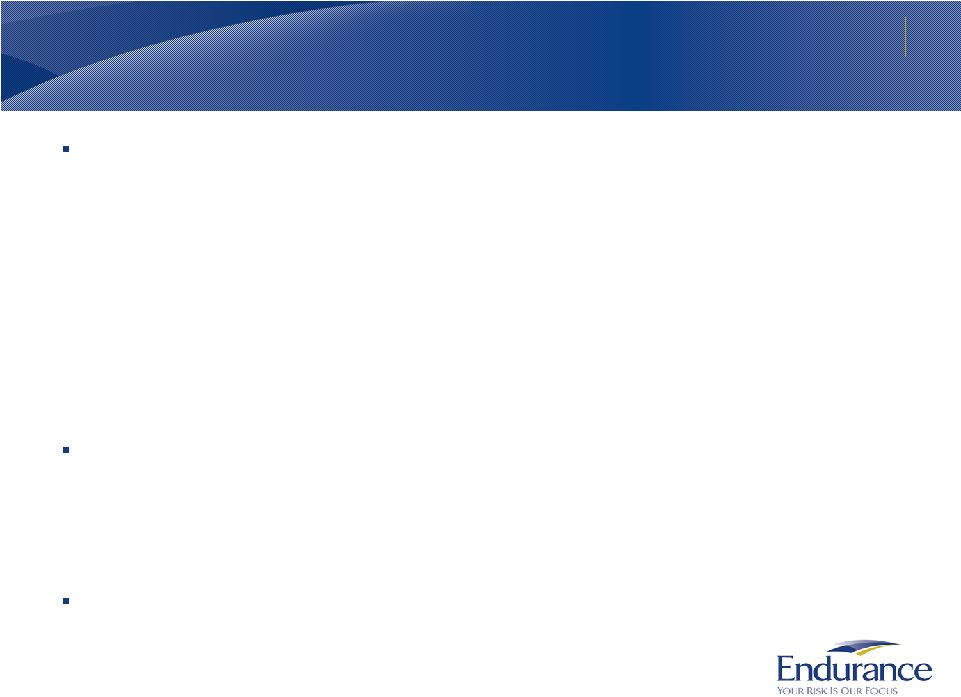 Conclusion
Endurance is a compelling investment opportunity
Endurance is undergoing a fundamental transformation
•
John Charman joined Endurance in late May 2013 as Chairman and CEO
•
Over the last 9 months, Jack Kuhn and Jerome Faure have joined the company as CEOs of our
insurance and reinsurance operations to build and expand our global specialty
insurance and reinsurance capabilities
•
Added numerous specialty reinsurance and insurance teams including trade credit and surety,
engineering, weather, inland marine and ocean marine, and within
specialty professional lines
•
Re-engineering or exiting underperforming businesses
•
In July 2013, completed cost savings initiatives which reduced number of senior
corporate executives by 30% and created annual cost savings of approximately $20
million which will help fund the necessary
build out and expansion of our underwriting businesses
Maintain excellent balance sheet strength and liquidity
•
High quality, short duration investment portfolio; fixed maturity investments have an average
credit quality of AA
•
Prudent reserving philosophy and strong reserve position; strong
history of favorable development
•
Capital levels exceed rating agency minimums providing support for growth
The outlook for Endurance’s book of business remains attractive
•
Adding specialty underwriting talent that is being funded by corporate reductions
•
Actively reduced volatility through writing less catastrophe and
property business
•
Geographically expanding our specialty insurance franchise
12 |
 Appendix |
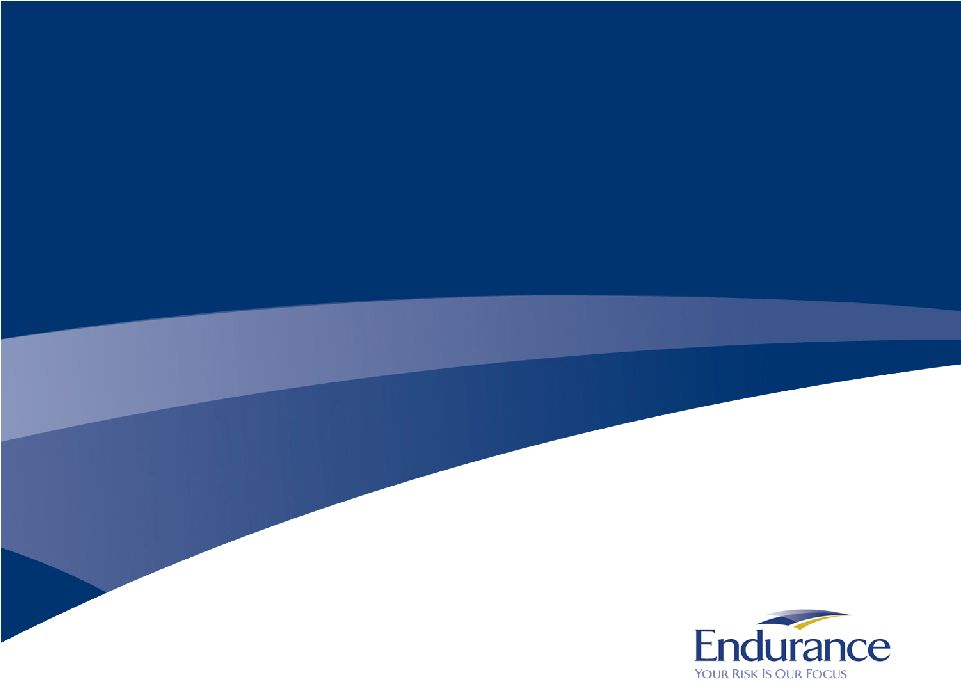 Overview of
ARMtech |
 Overview of
ARMtech Acquisition of ARMtech has been a great success for Endurance
Multi Peril Crop Insurance (MPCI) is an insurance product regulated by the USDA that provides
farmers with yield or revenue protection
•
Offered by 17 licensed companies (18 for crop year 2014)
•
Pricing is set by the government and agent compensation limits are also imposed -
no pricing cycle exists
•
Reduced downside risks due to Federally sponsored reinsurance and loss sharing
•
Agriculture insurance provides strong return potential, diversification in Endurance’s
portfolio of (re)insurance risks and is an efficient user of capital
ARMtech is a leading specialty crop insurance business
•
Approximate 7% market share (with estimated 175,000 policies in force) and is 5
th
largest of 17 industry
participants
•
MPCI 2013 crop year* estimated gross written premiums of $915 million
•
Portfolio is well diversified by geography and by crop
ARMtech was founded by software developers and has maintained a strong focus on providing
industry leading service through leveraging technology
Endurance
purchased
ARMtech
in
December
2007
at
a
purchase
price
of
approximately
$125
million
•
Since the acquisition, ARMtech has generated in excess of $110 million in operating profit
for Endurance •
ARMtech has grown MPCI policy count by 44.4% since 2007
15
* 2013 crop year is defined as July 1, 2012 through June 30, 2013
|
 ARMtech is a
Leader in the Crop Insurance Space ARMtech’s focus on technology and service has
allowed it to steadily grow its business Written Premiums and Policy Counts by Crop
Year Using technology and service to expand premiums
16
ARMtech has demonstrated its ability to grow market share and premiums over time through its
leading edge technology and superior delivery of service and compliance.
ARMtech has built a market leading specialty
crop insurance business through its focus on
offering excellent service supported by industry
leading technology.
MPCI policy count has grown 44.4% over the
past six years in a line of business not subject to
the property/casualty pricing cycle.
ARMtech is a leader in using technology to
deliver high quality service and to satisfy the
intense compliance and documentation
standards imposed on the industry by the U.S.
Federal Government.
ARMtech has generated strong underwriting
profits since inception.
* Estimated 2013 crop year premiums and policy count |
 ARMtech is
Increasing Market Share and Geographic Diversification 2012 and 2013 were
very strong marketing years for ARMtech MPCI Net Written Premiums by Crop Year and
State Grouping* Estimated 2013 Net Written Crop Year Premiums
17
ARMtech continues to focus on diversifying its business geographically while managing its
exposure to Texas through active use of available reinsurance protections.
2013 estimated crop year MPCI net written
premiums of $537.7 million are 10.2% higher
than crop year 2012
•
Commodity prices on corn and soybeans were
relatively flat compared to the prior year while
cotton declined in excess of 10%
•
Estimated policy count growth in excess of 11%
•
Greater cessions due to continued dry
conditions in parts of the United States
The portfolio of crop risk is more balanced in
2013 through greater crop and geographic
diversification and through greater cessions in
Texas (cotton concentration)
Purchased third party reinsurance to reimburse
for losses from 100% to 110%
* Group One States –
IL, IN, IA, MN, NE
Group Two States –
States other than Group One and Group Three states
Group Three States –
CT, DE, MA, MD, NV, NH, NJ, NY, PA, UT, WY, WV
** Estimated 2013 crop year premiums |
 Agriculture
Insurance is Not Correlated with the P&C Cycle FCIC reinsurance lowers
volatility Historic MPCI Crop Year Loss Ratio Results
(Pre and Post Federal Retrocessions)
Stable Results in Volatile Times
18
While individual states can produce highly varied gross loss ratios on a year to year basis,
the U.S. Federal reinsurance program has historically mitigated that volatility and
leaves ARMtech with a business which is not correlated to the traditional P&C
pricing cycle and has high risk adjusted return potential.
While individual states can produce large loss ratios,
the U.S. Federal reinsurance program has
historically reduced loss ratio volatility.
ARMtech’s business has historically produced
stable profits over time after reflecting the
reinsurance terms set out in the current
standard crop reinsurance agreement
•
Historic average loss ratio post U.S. Federal cessions
has been 81.6% [adjusted for the 2011 Federal
reinsurance terms]
•
The best year was 2007 with a 69.8% net loss ratio
and the worst was 2012 with a 104.0% net MPCI
loss ratio
•
ARMtech’s current expense run rate after the A&O
subsidy is approximately 6% -
8% |
 19
Overview of ARMtech
ARMtech’s recognition of premiums and earnings are influenced by growing
seasons
Seasonality of MPCI Business
Recognition of
annual written
premiums
60% -
65%
Spring crops
10% -
15%
Spring crop
adjustments due to
actual cessions
20% -
25%
Spring crop acreage
report adjustments
Winter crops
5% -
10%
Winter crop
adjustments
Recognition of
annual earned
premiums
10%-15%
Largely driven by
winter crops
25% -
30%
Driven by spring
crops and winter
crops
30% -
35%
Largely driven by
spring crops
25% -
30%
Largely driven by
spring crops
Commodity
price setting
Setting of base prices
for spring crops
(forward commodity
price for fourth
quarter)
Setting of base prices
for winter crops
(forward commodity
price for second
quarter)
Harvest
Harvest of winter
crops
Harvest of spring
crops
First Quarter
Second Quarter
Third Quarter
Fourth Quarter
Harvest price
determined for
winter crops
Harvest price
determined for
spring crops |
 Geographic
Diversification of Crop Insurance Business ARMtech maintains a geographically diversified
portfolio of risk 20
2013 Estimated Crop Year Net Written Premiums
1.9%
0.8%
0.5%
1.8%
0.6%
0.7%
5.8%
2.4%
5.7%
1.0%
2.8%
18.7%
1.7%
2.2%
0.8%
3.3%
10.9%
7.5%
0.7%
2.1%
0.4%
4.3%
2.7%
1.3%
2.2%
4.3%
1.3%
3.3%
3.8%
2.2%
0.6%
0.4% |
 21
Diversification of Crops Within ARMtech’s Portfolio
Underwritten risks diversified by geography and commodity type
ARMtech’s 2013 Estimated Crop Year MPCI Net Written Premiums
Iowa –
7.6%
Nebraska –
4.0%
Minnesota –
3.6%
Indiana –
2.6%
Texas –
2.4%
North Dakota –
2.0%
Missouri –
1.8%
South Dakota –
1.8%
Illinois –
1.5%
Mississippi –
1.3%
Colorado –
1.2%
Kentucky –
0.7%
Tennessee –
0.7%
Ohio –
0.7%
Arkansas –
0.7%
South Carolina –
0.6%
Wisconsin –
0.4%
All other states –
1.9%
Corn
(35.5%)
Texas –
8.4%
Georgia –
1.5%
Alabama –
0.6%
Mississippi –
0.5%
South Carolina –
0.5%
All other states –
1.0%
Cotton
(12.5%)
Iowa –
3.3%
Minnesota –
2.5%
Mississippi –
2.1%
Nebraska –
1.5%
Indiana –1.5%
Missouri –
1.2%
North Dakota –
1.1%
Kentucky –
1.1%
Arkansas –
0.9%
All other states –
4.8%
Soybeans
(20.0%)
Other Crops
(20.1%)
Wheat
(13.3%)
Texas –
3.7%
North Dakota –
1.4%
Colorado –
1.1%
Oklahoma –
1.1%
Idaho –
1.0%
Minnesota –
0.8%
All other states –
4.2%
Grain Sorghum –
2.4%
Citrus, Nursery & Orange Trees -
3.1%
Apples –
1.2%
Pasture, Rangeland, Forage –
1.1%
Potatoes –
1.0%
Peanuts –
0.9%
Barley –
0.9%
Rice –
0.9%
Tobacco –
0.8%
Dry Beans –
0.7%
All other crops –
5.7% |
 22
Agriculture Insurance Contains Three Layers of Risk Mitigation
Farmers retention, ceding premiums to the U.S. Federal Government and limitations on
losses and gains
2013 Crop Year
Gross Liability
Assigned Risk Fund
“Higher Risk Policies”
68.8% of risk retained by
ARMtech
31.2% of first dollar risk retained
by farmers
Commercial Fund
“Lower Risk Policies”
41.6% of MPCI Premiums Ceded to U.S. Federal Government
Loss Sharing
(% of loss retained by
Loss Ratio
Loss Ratio
Group 1 States
Group 2 & 3 States
ARMtech within each
100 - 160
7.5%
100 - 160
65.0%
42.5%
applicable band when
160 - 220
6.0%
160 - 220
45.0%
20.0%
the loss raio is above 100%.)
220 - 500
3.0%
220 - 500
10.0%
5.0%
Gain Sharing
(% of gain retained by
Loss Ratio
Loss Ratio
Group 1 States
Group 2 & 3 States
ARMtech within each
65 - 100
22.5%
65 - 100
75.0%
97.5%
applicable band when
50 - 65
13.5%
50 - 65
40.0%
40.0%
the loss raio is below 100%.)
0 - 50
3.0%
0 - 50
5.0%
5.0%
14.2% of 2013
Crop Year NWP
85.8% of 2013
Crop Year NWP |
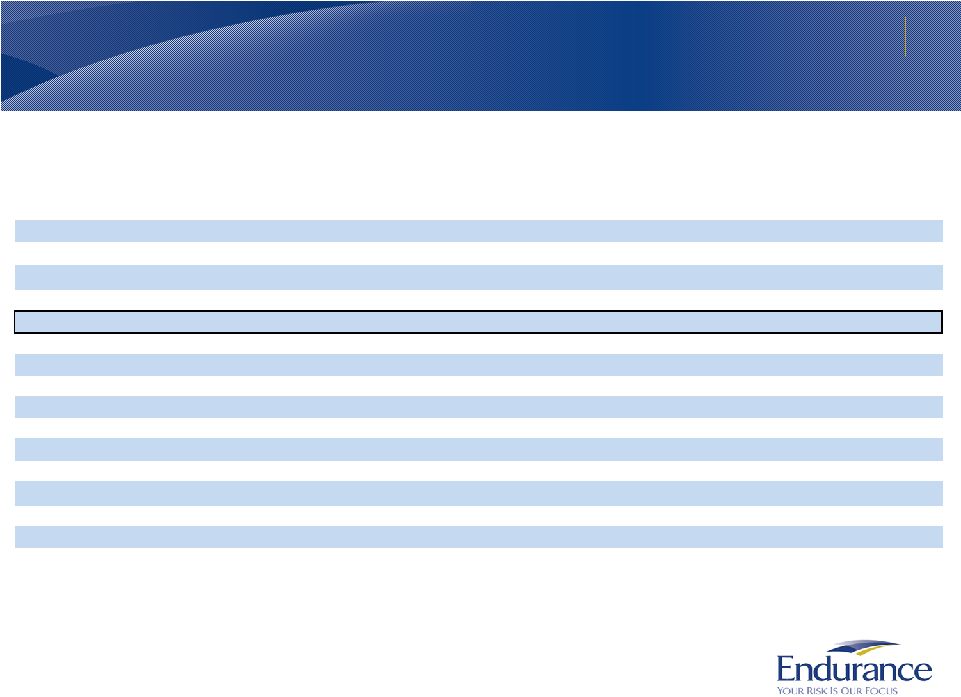  ARMtech Has Grown
Market Share Over Time Superior service and technology has driven growth in stable
market 23
Crop Year Market Share
% Change in
Market Share
MPCI Certified Companies (Owners)
2012
2011
2010
2009
2008
2007
2007 - 2012
Rural Community Insurance Company (Wells Fargo)
22.1%
21.8%
22.9%
24.7%
25.2%
25.1%
-3.0%
Rain and Hail (ACE)
(1)
21.3%
21.8%
22.6%
24.3%
24.1%
25.0%
-3.7%
NAU Country Insurance Company (QBE)
(1)
13.3%
14.8%
14.4%
13.7%
13.8%
13.3%
0.0%
Great American Insurance Co.
8.5%
8.7%
8.7%
9.1%
10.1%
10.6%
-2.1%
American Agri-Business Ins. Co. (Endurance)
7.4%
6.7%
7.0%
6.5%
5.7%
5.9%
1.6%
Producers Ag. Ins. Co. (CUNA Mutual)
5.5%
6.4%
6.3%
5.3%
5.2%
4.8%
0.7%
Farmers Mutual Hail Ins. of Iowa
4.4%
4.5%
4.2%
3.8%
4.0%
4.0%
0.4%
Guide One Mutual (CGB Diversified Services)
4.0%
2.7%
2.0%
1.2%
1.2%
1.1%
2.9%
John Deere Risk Protection, Inc.
3.3%
3.3%
3.8%
4.0%
3.3%
3.0%
0.2%
Agrinational Insurance Company (ADM)
2.5%
2.1%
1.5%
0.9%
1.0%
1.1%
1.4%
Heartland (Everest Re)
2.3%
2.4%
3.0%
3.4%
3.3%
3.2%
-1.0%
AgriLogic (Occidental Firs & Casualty Co)
1.8%
1.4%
0.1%
0.0%
0.0%
0.0%
1.8%
Hudson Insurance Company
(1)
1.6%
1.2%
1.2%
0.8%
0.6%
0.4%
1.2%
American Agricultural Ins. Co (Amer. Farm Bureau)
1.3%
1.3%
1.3%
1.4%
1.4%
1.2%
0.1%
Country Mutual Insurance Company
0.9%
0.9%
1.0%
1.1%
1.2%
1.4%
-0.5%
Source - National Crop Insurance Services (NCIS)
(1) 2007 Crop Year Market Share was increased to reflect the acquisition of a company between
2007 and 2012. |
 Other
Miscellaneous Information |
 The net loss
estimates by zone above represent estimated losses related to our property, catastrophe and other specialty lines of business, based upon our catastrophe models and
assumptions regarding the location, size, magnitude, and frequency of the catastrophe events
utilized to determine the above estimates. The net loss estimates are presented on an
occurrence basis, before income tax and net of reinsurance recoveries and reinstatement
premiums, if applicable. Return period refers to the frequency with which the related size of a
catastrophic event is expected to occur.
Actual realized catastrophic losses could differ materially from
our net loss estimates and our net loss estimates should not be
considered as representative of the actual losses that
we may incur in connection with any particular catastrophic event.
The net loss estimates above rely significantly on computer models created to simulate the
effect of catastrophes on insured properties based upon data emanating from past
catastrophic events. Since comprehensive data collection regarding insured losses from catastrophe events is a relatively recent
development in the insurance industry, the data upon which catastrophe models is based is
limited, which has the potential to introduce inaccuracies into estimates of losses from
catastrophic events, in particular those that occur infrequently. In addition,
catastrophe models are significantly influenced by management's assumptions regarding event characteristics,
construction of insured property and the cost and duration of rebuilding after the
catastrophe. Lastly, changes in Endurance's underwriting portfolio risk control mechanisms and other
factors, either before or after the date of the above net loss estimates, may also cause
actual results to vary considerably from the net loss estimates above. For a listing of risks related to
Endurance and its future performance, please see "Risk Factors" in our Annual Report
on Form 10-K for the year ended December 31, 2012. 25
Probable Maximum Loss by Zone and Peril
Largest 1 in 100 year PML as of July 1, 2013 is equal to 12.8% of Shareholders’
Equity
as of June 30, 2013
Values in $ Millions
Estimated Occurrence Net Loss as of July 1, 2013
July 1, 2012
July 1, 2011
10 Year
25 Year
50 Year
100 Year
250 Year
100 Year
100 Year
Return
Return
Return
Return
Return
Return
Return
Zone
Peril
Period
Period
Period
Period
Period
Period
Period
United States
Hurricane
$143
$225
$284
$350
$420
$468
$564
Europe
Windstorm
85
171
249
331
441
344
445
California
Earthquake
43
185
237
284
397
412
442
Japan
Windstorm
37
123
188
230
239
247
268
Northwest U.S.
Earthquake
-
5
31
89
194
184
241
Japan
Earthquake
10
55
105
137
195
138
185
United States
Tornado/Hail
38
57
73
89
113
96
98
Australia
Earthquake
1
6
29
87
189
83
95
New Zealand
Earthquake
1
3
9
23
51
22
34
Australia
Windstorm
3
12
30
58
109
37
39
New Madrid
Earthquake
-
-
-
7
70
11
14 |
 Endurance is
World Class at Risk Management Endurance has performed well versus peers in recent large
catastrophe events 26
Catastrophe Losses versus Shareholder Equity
From December 31, 2006 –
June 30, 2013
Note:
Catastrophe loss values were obtained through publicly released information and company
transcripts for each quarter
and
include
current
quarter
losses
as
well
as
announced
loss
reserve
development
associated
with
prior quarter
catastrophe losses. Catastrophe losses are compared with starting Total Shareholder
Equity for each loss quarter. |
 Second Quarter
2013 Highlights Results were driven by higher catastrophes losses offset by favorable
development Book value per common share, adjusted for dividends, declined 3.4% during
second quarter 2013 •
Mark to market adjustments on fixed income portfolio as interest
rates rose and credit spreads widened
•
Common stock sold to John Charman and issuance of restricted shares and options diluted book
value per share $0.91 in the quarter
•
Net income attributable to common shareholders of $52.8 million
Net written premiums of $464.6 million were 4.1% lower than second quarter 2012
•
Insurance net written premiums of $191.5 million increased 2.6% from second quarter
2012 -
Improvement in agriculture policy count in excess of 9% was partially offset by greater
cessions to the U.S. Government and third parties and overall agriculture insurance
net written premiums grew 25.7% -
Reduction in professional lines as a result of exiting a program
relationship in late 2012
•
Reinsurance net written premiums of $273.1 million declined 8.3%
compared to second quarter 2012
-
Reduced limits and rate reductions led to a $20.8 million decline in catastrophe
premiums -
Property premiums declined $9.5 million due to non-renewing business that no longer meets
our profit targets
-
Growth in casualty as a result of one new treaty representing approximately $8.3 million in
premium 27 |
 28
Financial Results for Second Quarter 2013
$MM (except per share data and %)
June 30,
2 0 1 3
June 30,
2 0 1 2
$
Change
%
Change
Net premiums written
464.6
484.4
(19.8)
-4.1%
Net premiums earned
543.3
519.3
24.0
4.6%
Net investment income
32.5
31.8
0.7
2.2%
Net underwriting income
31.9
38.7
(6.8)
-17.6%
Net income per common shareholders
52.8
64.3
(11.5)
-17.9%
Operating income per common
shareholders
47.3
51.3
(4.0)
-7.8%
Fully diluted net income EPS
1.21
1.48
(0.27)
-18.2%
Fully diluted operating income EPS
1.09
1.18
(0.09)
-7.6%
Financial highlights
June 30,
2 0 1 3
June 30,
2 0 1 2
Operating ROE
8.2%
9.0%
Net loss ratio
66.1%
66.5%
Acquisition expense ratio
13.2%
13.9%
General and administrative expense ratio
15.0%
12.1%
Combined ratio
94.3%
92.5%
Diluted book value per share
$51.95
$53.48
Investment leverage
2.75
2.72
Key operating ratios |
 29
Second Quarter 2013 Net Written Premiums
In $MM
June 30,
2 0 1 3
June 30,
2 0 1 2
$
Change
%
Change
Property
15.8
12.0
3.8
31.7%
Casualty and other specialty
63.4
64.6
-1.2
-1.9%
Agriculture
84.5
67.3
17.2
25.6%
Professional lines
27.8
42.8
-15.0
-35.0%
Total insurance
191.5
186.7
4.8
2.6%
Insurance Segment
In $MM
June 30,
2 0 1 3
June 30,
2 0 1 2
$
Change
%
Change
Casualty
67.2
58.9
8.3
14.1%
Property
44.5
54.0
-9.5
-17.6%
Catastrophe
138.0
158.9
-20.9
-13.2%
Other specialty
23.4
26.0
-2.6
-10.0%
Total reinsurance
273.1
297.8
-24.7
-8.3%
Reinsurance Segment |
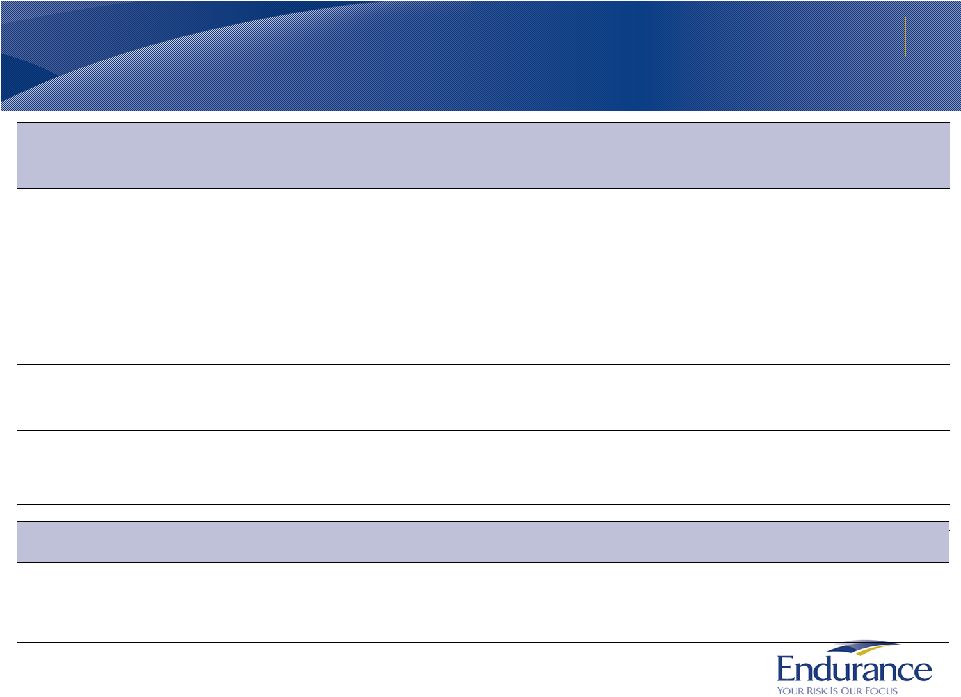 30
Financial Overview: Inception to Date Financial Performance
In $MM
2002
2003
2004
2005
2006
2007
2008
2009
2010
2011
2012
2Q13 YTD
Inception
to date
Net premiums
written
765
1,598
1,697
1,619
1,586
1,575
1,784
1,606
1,764
1,980
2,029
1,374
19,377
Net premiums
earned
369
1,174
1,633
1,724
1,639
1,595
1,766
1,633
1,741
1,931
2,014
963
18,182
Net underwriting
income (loss)
51
179
232
-410
304
322
111
265
195
-252
-48
96
1,045
Net investment
income
43
71
122
180
257
281
130
284
200
147
173
82
1,970
Net income (loss)
before preferred
dividend
102
263
356
-220
498
521
100
555
365
-94
163
161
2,770
Net income (loss)
available to
common
shareholders
102
263
356
-223
483
506
85
539
349
-118
130
145
2,617
Diluted EPS
$1.73
$4.00
$5.28
($3.60)
$6.73
$7.17
$1.33
$9.00
$6.38
($2.95)
$3.00
3.34
$41.41
Financial highlights from 2002 through June 30, 2013
Key Operating Ratios
2002
2003
2004
2005
2006
2007
2008
2009
2010
2011
2012
2Q13
Inception
to date
Combined ratio
86.2%
84.7%
85.8%
123.5%
81.5%
79.9%
93.5%
84.0%
88.7%
112.9%
102.3%
90.2
94.2%
Operating ROE
7.8%
17.3%
19.9%
(11.9%)
25.7%
23.8%
8.5%
22.0%
12.6%
(6.3%)
2.4%
12.0
10.9%
Book value per share
$21.73
$24.03
$27.91
$23.17
$28.87
$35.05
$33.06
$44.61
$52.74
$50.56
$52.88
$51.95 |
